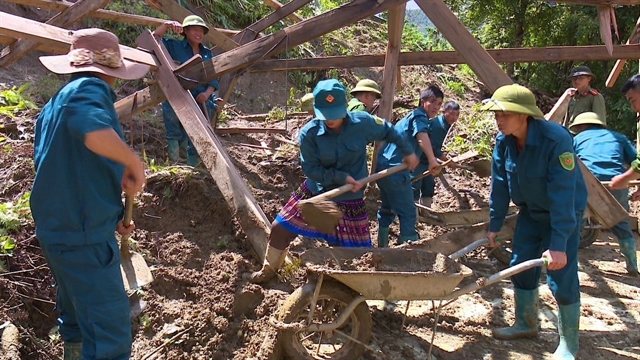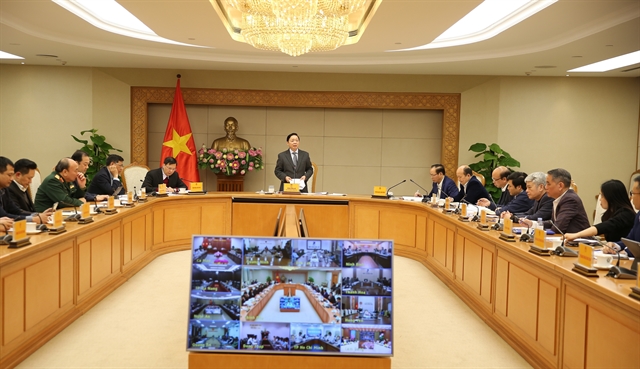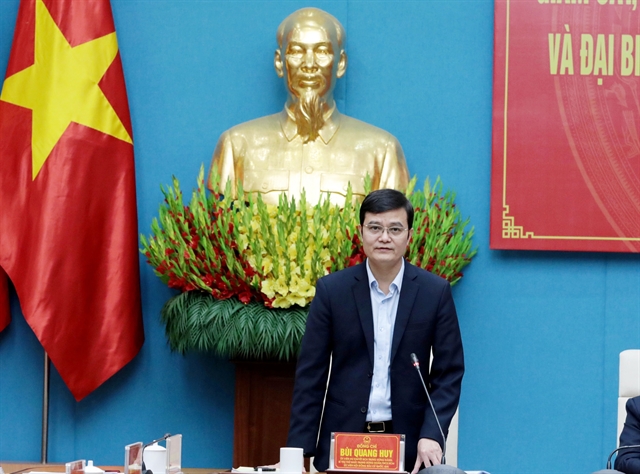 Environment
Environment

 |
| Disaster prevention shock forces in Lào Cai Province help people clean up after a flash flood in 2024. – VNA/VNS Photo |
HÀ NỘI — Communal-level disaster prevention shock forces must be regularly reinforced, properly trained and equipped with the necessary tools, while being supported by clear policies to ensure readiness, officials have urged.
As natural disasters grow increasingly complex and unpredictable, posing severe threats to lives and property, many experts say localities should both establish dedicated disaster prevention forces and reorganise the 'four on-the-spot' model to operate more flexibly.
They recommend combining professional rescue teams with local forces and allocating mobile response points more effectively.
The call comes as Việt Nam’s local government system shifts from three tiers to two tiers from July 1, 2025, placing communes on the frontline with full responsibility for disaster prevention and control.
Heavier burden for communes
Lieutenant General Lê Phúc Nguyên, Vice Chairman of the Management Council of the Disaster Prevention Community Fund, noted that the merger of communes increases their size and population, making disaster prevention duties more demanding.
Many tasks previously managed at district level have now been transferred to the commune, requiring greater attention to the shock force.
"If not properly organised, trained and equipped, communal shock forces will not be able to fulfil their mission," Nguyên warned, stressing that they are the core units responsible for receiving orders from higher levels, relaying information to the public and implementing pre-rehearsed response scenarios.
He called for a thorough review and regular reinforcement of these forces, along with skill training, equipment provision and clear benefit policies to maintain readiness. Current allowances, he said, remained limited and failed to encourage long-term commitment.
Nguyên proposed that the Government issue specific regulations for organising communal shock forces, especially in disaster-prone areas, and that local authorities adopt appropriate incentives to ensure dedication and readiness.
Village and hamlet heads, he added, play a critical role in executing evacuation plans during emergencies.
Nguyễn Văn Hiếu from Ninh Bình Province's Irrigation Sub-Department agreed, pointing out that youth shock troops and commune-level forces still face mobility limitations in emergencies.
Recalling Typhoon No.7 in 2005, which caused heavy damage in northern coastal provinces, he said some critical locations could not be reached by manpower alone.
He suggested that instead of relying solely on supplies stored along dikes, reserves from other points and mechanised equipment from about 5km away could be mobilised faster and more effectively.
A combination of professional and local forces, along with strategically placed mobile points, would open new options for resource deployment during incidents, he added.
Local initiative and responsibility
In Ninh Bình Province’s Gia Phong Commune, local authorities have proactively implemented disaster prevention measures since the two-tier system came into effect, according to Vice Chairman of the commune People’s Committee Đinh Thành Nam.
Nam highlighted the leadership’s sense of responsibility, particularly in enforcing Government Decree 200 on civil defence and consolidating the commune-level Civil Defence Command.
However, he acknowledged challenges, including inexperienced staff, limited financial and technical resources and inadequate weather monitoring systems.
He proposed clearer regulations on the division of powers and responsibilities between government levels, the assignment of highly qualified technical staff to guide localities, investment in upgraded meteorological and hydrological monitoring systems and adequate supply and equipment preparation.
Effective implementation of Decree 200, combined with local initiative and timely higher-level support, would be key to strengthening resilience, Nam said.
Nguyễn Hữu Thành, Deputy Director of the Department of Local Government under the Ministry of Home Affairs, said the Government had reviewed and amended legal documents to ensure effective decentralisation.
"In disaster prevention, provinces coordinate and supervise while communes serve as the centre for implementing tasks, communication and public awareness," he explained.
The Law on Local Government Organisation stipulates that provinces focus on macro, interregional strategies, while communes are responsible for implementing policy and delivering essential public services.
"There are no longer concerns over authority and responsibilities – over 90 per cent of tasks are now carried out thoroughly at the commune level," Thành said, noting that some provinces have successfully assigned inter-communal tasks to commune administrations.
Provincial people’s committees could propose delegating certain powers to communes if they are capable, and chairpersons might authorise other administrative units or make urgent decisions in disaster prevention situations. — VNS




